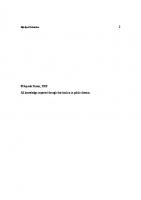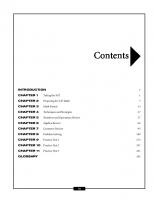The Ultimate Guide to SAT Grammar by Erica Meltzer (digital sat) [6 ed.] 9781733589598
3,411 305 23MB
english Pages 218 Year 2023
Recommend Papers
![The Ultimate Guide to SAT Grammar by Erica Meltzer (digital sat) [6 ed.]
9781733589598](https://ebin.pub/img/200x200/the-ultimate-guide-to-sat-grammar-by-erica-meltzer-digital-sat-6nbsped-9781733589598.jpg)
- Author / Uploaded
- Erica L. Meltzer
File loading please wait...
Citation preview
Sixth Edition
'THE ULTIMATE GUIDE TO ®
GRAMMAR A complete chapter devoted to each concept
FOR THE Strategies to improve speed and accuracy
DIGITAL
Test-style exercises to apply what you've learned
SAT®
In-depth explanations to help you identify rules tested in different ways
Erica L. Meltzer author of The Critical Reader ' ':,( . ' . ~-~;~V.\> SAT., is a trademark registered by the College Board,; wry~ch is not affiliate·d withf ana aoes not endorse, '
'
,,''
·~"'~
t.. ~··l)
4,
The Ultimate Gui e t SAT®Grammar Sixth Edition
Erica L. Meltzer
IITHE CRITICAL READER New York
-
Copyright© 2011-2023 The Critical Reader Cover© 2023 Tugboat Design All rights reserved. No part of this publication may be reproduced in any form or by any means, electronic or mechanical, including photocopy, recording, or any information storage and retrieval system, without written permission from the publisher. For information regarding bulk purchases, reprints, and foreign rights, please send correspondence to [email protected]. SAT® is a trademark registered by the College Board, which is not affiliated with, and does not endorse, this publication. ISBN-13: 978-1-7335895-9-8
DEDICATION To Emma and Joey, for whom these exercises were first written. I know you never asked to have a grammar book dedicated to you, but I hope you'll accept the gesture. And to Jane, Joe, Lily, and Frisco, for food, company, inspiration, and hilarity.
iii
ALSO BY ERICA MELTZER
The Ultimate Guide to SAT® Grammar Workbook SAT® Vocabulary: A New Approach (with Larry Krieger) The Critical Reader: The Complete Guide to SAT® Reading The Critical Reader: AP® English Language and Composition Edition The Complete Guide to ACT® English The Complete Guide to ACT® Reading The Complete GMAT® Sentence Correction Guide GRE® Vocabulary in Practice How to Write for Class: A Student's Guide to Grammar, Punctuation, and Style IELTS® Writing: Grammar and Vocabulary
iv
Table of Contents Introduction: How to Use This Book
7
Cheat Sheet
8
Part I: Non-Grammar Questions
9
1.
Transitions
11
2.
Specific Focus ("Student Notes")
27
Part II: Punctuation
37
Parts of Speech
39
3.
Sentences and Fragments
45
4.
Joining and Separating Sentences
59
5.
Joining Sentences and Fragments
72
6.
Non-Essential & Essential Clauses
81
7.
Additional Comma Uses and Misuses
106
Cumulative Review: All Transitions and Punctuation
113
Part Ill: Grammar
119
8.
Verbs: Agreement and Tense
121
9.
Pronouns
143
10.
Apostrophes
155
11.
Modification
162
12.
Parallel Structure
169
Cumulative Review: Verbs, Pronouns, and Modification
174
Practice Sets: All Chapters
178
Appendix: Additional Concepts
193
A.
Word Pairs and Comparisons
195
8.
Question Marks
199
Answer Key
201
V
vi
vi
Introduction: How to Use This Book The purpose of this book is to prepare you for the full range of concepts tested on the digital SAT®. More specifically, it is to teach you to apply those concepts to the specific ways in which they are tested on the exam. Instead of providing explanations and examples for a single version of a rule and leaving you to deduce its subtler or more complex applications, this book walks you through multiple versions of each concept, showing you how it can be tested from various angles and in combination with other concepts. The chapters are ordered in roughly the order of the frequency with which they appear on the test. If you have limited time to study, you should focus on Parts I and II, as the principles covered there make up the vast majority of Writing questions. If you are attempting to cram for the SAT-something that, for the record, I strongly do not recommend - or have an extremely limited amount of study time, you should focus on Part I as the question types covered there are virtually guaranteed to appear on every exam. If you do not plan to take the SAT for a while, however, I encourage you to work through all of the chapters in order. Although that approach will obviously require more time, it will also allow you to acquire a very solid foundation. Knowing why you are answering questions correctly, rather than simply relying on your ear, will improve both your speed and your confidence. Otherwise, you risk second-guessing yourself if a concept is tested in an unfamiliar way.
While the shorter Writing portion on the digital SAT may make the testing process less tedious, the downside to this change is that each question counts more. If you are aiming for a very high score, you must also be prepared to encounter questions testing a fairly wide range of concepts, even if only a small number of them will appear on your exam. Although the majority of questions focus on a few key areas, the remaining items are likely to be drawn from a fairly broad pool. The test, after all, cannot be made too predictable. Moreover, because of the adaptive nature of the exam, it is crucial that you answer as many questions as possible correctly in the first section, and there is no reason to lose what can be easy points. It is also important not to confuse having a lot of time to answer each question (more than a minute on the digital test versus just under 50 seconds on the paper-based version) with needing that time. Regardless of how many seconds you technically have, you should aim to work efficiently. Remember that you do not need to answer the questions in order, and it is possible to use that fact to your advantage. If you read at a good speed and know precisely what you are looking for, some Writing questions can be answered in a matter of seconds. That leaves you plenty of time to return to more complex and time-consuming Reading questions, for example. If you are very comfortable working out of order, you may even want to answer all the Writing questions first so that you can focus more fully on the Reading questions. Although this book sometimes goes into a fair amount of grammatical depth, its ultimate goal is to teach you to simplify-thatis, to quickly identify just what each question type is testing so that you do not become distracted by irrelevant details, and to reduce seemingly complicated questions down to their essential terms. In addition, concepts that could plausibly be tested but that have not (yet) appeared on a released exam are noted as such in the text. Even in the new digital format, the Writing and Language Test remains one of the more predictable components of the SAT. While the particular exam you take may contain a "wild card" question or two, in general, the vast majority of the material tested can be safely anticipated. The goal of this book is to teach you how to anticipate it. - Erica Meltzer
7
SAT Writing Cheat Sheet 1.
Read the full passage, not just the portion surrounding the blank, and always plug your answer back into the passage to double-check it.
2.
Transition questions: determine the relationship between the two sentences (continue, cause-and-effect, contradict) before you look at the answer choices. (Ch. 1)
3.
A conjunctive adverb (e.g., however, therefore, moreover) at the start of a sentence follows a period, semicolon, colon, or dash. A conjunctive adverb in the middle of a sentence is surrounded by commas (Ch. 1)
4.
"Student Notes": identify the key word/ phrase in the question (what the "student" wants to emphasize, present, or introduce), and find the answer that rewords it. Avoid looking at the bullet points . .(Ch. 2)
5.
A transition in the middle or at the end of a sentence= relationship to the 12revious sentence. (Ch 4)
6.
Period= Semicolon= Comma+ and/but. (Ch. 4)
7.
Comma+ it, this, s/he, they usually (but not always) = comma splice = WRONG. (Ch. 4)
8.
Joining/ separating sentences: check answers with a period or colon first. (Ch. 4)
9.
Colon= Single Dash= Explanation or List. A full sentence is required before but not after. (Ch. 5)
10.
2 Commas= 2 Dashes= 2 Parentheses= Non-Essential Clause. If the information between these punctuation marks is crossed out, the sentence will still make sense. BUT commas, dashes, and parentheses cannot be mixed and matched. (Ch. 6)
11.
Singular verbs end in -s; plural verbs do not end in -s, e.g., it suggests, they suggest. Remember that the noun right before a verb may not be the subject. (Ch. 8)
12.
Subject-verb agreement questions may "pose" as tense questions. If the answers include singular vs. plural verbs, focus on agreement. (Ch. 8)
13.
Keep verb tense/ form consistent. An underlined verb should stay parallel to the surrounding verbs unless there is a clear reason for the tense to change. Check other verbs for context. (Ch. 8)
14.
Pronoun agreement: singular nouns= it (things); plural nouns= they. (Ch. 9)
15.
Dangling modifier: a descriptive phrase set off by a comma must be followed by the noun described (Ch. 11)
8
art I: Non-Gramm r Questions
9
10
·1.•
I•. · ·. ..
Transitions
Transition questions are the most common type of Writing question, with each test containing around eight to 10 such items-around 15-20% of the test. As a result, you should make sure that you are comfortable working with both common and less common transitional words and phrases. (An extended list is provided on p. 19.) On the SAT, you must also be able to recognize when transitions do and do not create logical connections between two sentences or parts of a sentence. Usually, these questions contain four grammatically acceptable answers; the focus is on testing your ability to identify the most logical option in context.
-.-
Let's start by looking at a typical example. We're going to look at it without the answers for now.
:- - - - - - - - - - - - - - - - - - - - - - - - - - - - - - - - - - - - - - - - - - - - - - - - - : Although T.S. Eliot devoted several years to writing : "The Waste Land," it sold only about 330 copies in : the six months following its publication in 1922. Eliot was forced to seek other sources of income. In the mid-1920s, he took a job as the , director of a new publishing firm called Faber & ' Faber.
- -. - - -.
-.- - - - - - - -- - - - -. - .- - - - - - .•
Mark.for Review
-.
- - -. - - - - - - -:
.
..
:
- - - - - - - - - - - - - - - - - - - - - - - - - - - - - '-·- - - - - - - - - -' Which choice completes the text with the most logical transition?
I ® I -------I ® I -------I © I --------
![The Ultimate Guide to SAT Grammar [4 ed.]
0997517867, 9780997517866](https://ebin.pub/img/200x200/the-ultimate-guide-to-sat-grammar-4nbsped-0997517867-9780997517866.jpg)



![Barron's SAT 1600: Revised for the NEW SAT [5 ed.]
9781438068107](https://ebin.pub/img/200x200/barrons-sat-1600-revised-for-the-new-sat-5nbsped-9781438068107.jpg)



![Gruber's complete SAT guide 2014 [17th ed]
9781402279737, 1402279736](https://ebin.pub/img/200x200/grubers-complete-sat-guide-2014-17th-ed-9781402279737-1402279736.jpg)
